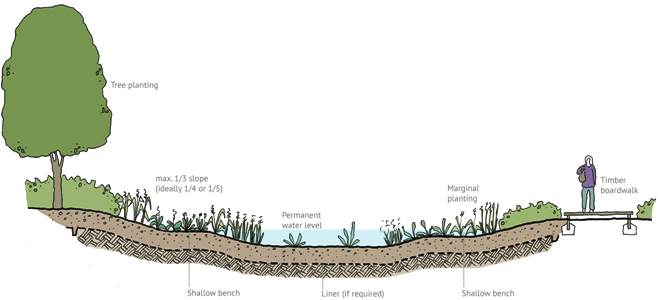- Delivering SuDS
- Using SuDS
- Background
- SuDS principles
- Benefits of SuDS
- Benefits of SuDS
- Why developers should choose SuDS
- Flood risk management
- Water quality management
- Biodiversity & ecology
- Amenity
- Air quality
- Building temperature
- Carbon reduction and sequestration
- Crime
- Economic growth
- Enabling development
- Flexible infrastructure/climate change adaptation
- Education
- Groundwater recharge
- Health and well being
- Pumping wastewater
- Rainwater harvesting
- Recreation
- Tourism
- Traffic calming
- Treating wastewater
- SuDS components
- SuDS components overview
- Source control
- Swales & conveyance channels
- Filtration
- Infiltration
- Retention & detention
- Wetlands
- Inlets, outlets and control structures
- SuDS performance & monitoring
- Delivery
- The costs & benefits of SuDS
- Adoption & maintenance of SuDS
- Legislation & regulation
- Design guidance
- Retrofitting SuDS
- Drainage exceedance
Wetlands overview
Wetlands are densely vegetated water bodies that use sedimentation and filtration to provide treatment of surface water runoff.
Wetlands generally consist of an inlet zone (sediment basin) a macrophyte zone, which is shallow, densely vegetated area; and a high flow bypass channel, which is typically a wide vegetated swale from the inlet pond around the side of the wetland.
Where ever possible wetlands should be the last stage of the SuDS management train and should be one of the last treatment stages, otherwise there's a risk of extensive siltation (unless there is upstream treatment). They remove fine sediments, metals and particulates, and dissolved nutrients. Wetlands mainly treat polluted runoff, provide attenuation and deliver biodiversity and amenity. Increasingly they’re also being used as a valuable educational resource. Click here for more detail on wetlands.
Wetlands can be constructed on a variety of scales. In highly urbanised areas, wetlands can have a hard edge or be part of the streetscape or other hard landscaping features and furniture. They must be appropriately sized for the catchment to ensure the hydraulics support water treatment.
Upstream components both control the flow and level of siltation allowing wetlands and ponds to polish the runoff. This is achieved by ensuring water flows slowly through the wetland over an extended period of time (known as the residence time). An important mechanism is also the breakdown of oils by natural organisms. They need a good supply of oxygen which means the permanent water must be shallow enough so that oxygen can reach the bottom of the wetland.
Wetland benefits
|
|
|
|
|
|
|
|
|
|
|
|
Read more on:





